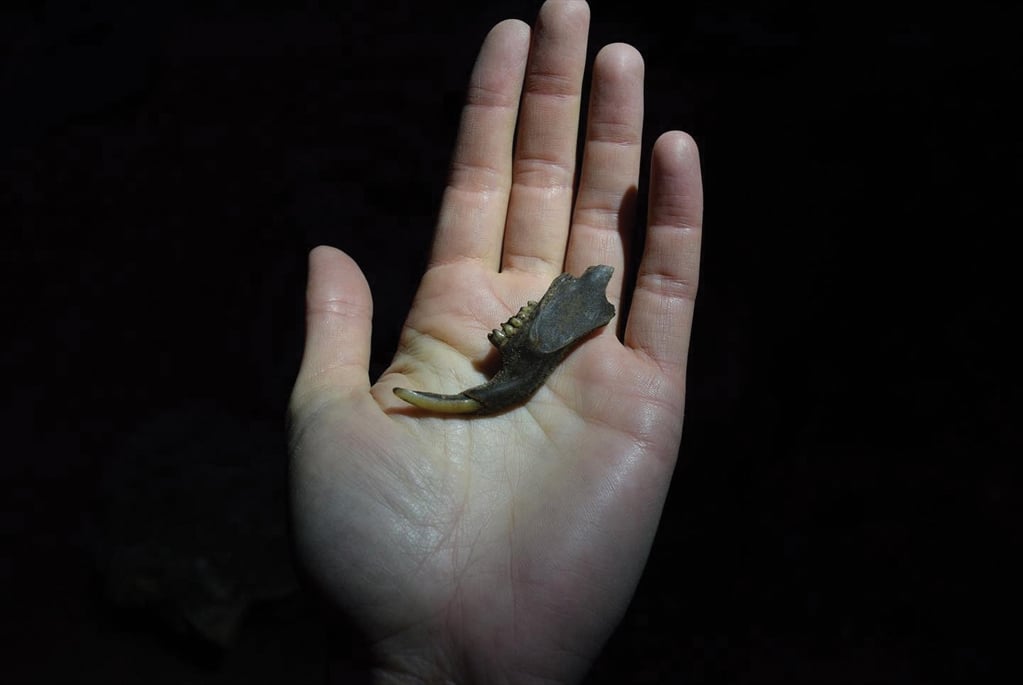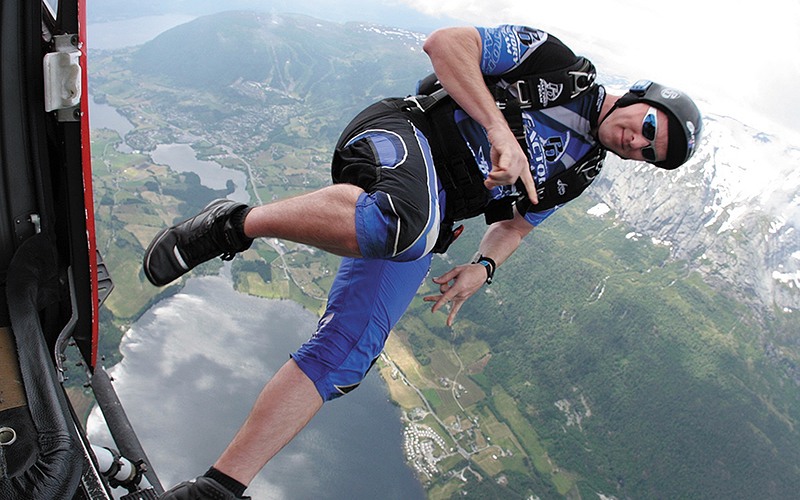Big Ideas On Living
By: Tony Rehagen, Daniel P. Smith, and Kelley Freund | Categories: Alumni Association News
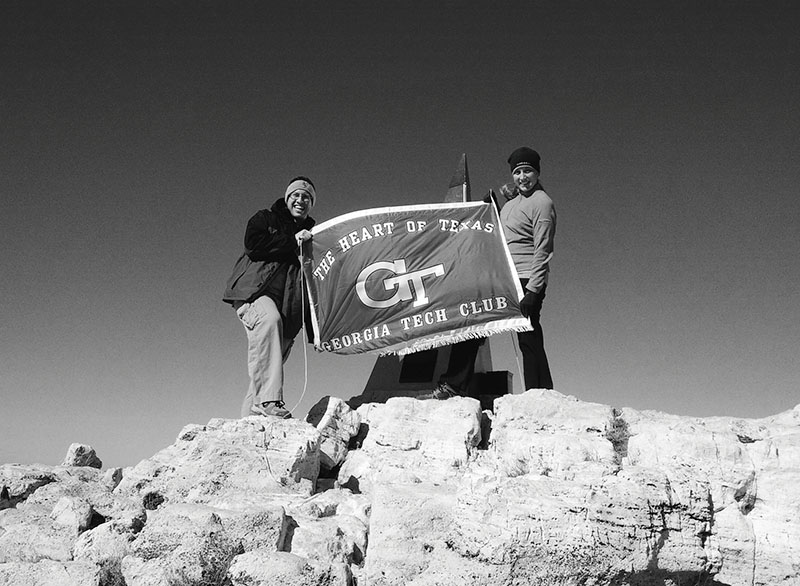
See where "going big" has led these Yellow Jackets
What happens when you super-size an idea? At Georgia Tech, students grow their ideas into ambitious projects for good. Their ideas sprout into companies through programs such as CREATE-X. They tackle entrenched issues using a multidisciplinary approach through the Vertically Integrated Projects Program, which pairs students with faculty to work on long-term project teams. Georgia Tech instills the skills to help Yellow Jackets bring their ideas to fruition. On the next pages, the Alumni Magazine takes a look at what happens when you super-size an idea. From a researcher taking on a deep problem facing big tech to a couple, who took a giant leap in their personal and professional lives, gain insight into what happens when you “go big.”
Tech Grads Turned Globetrotters
Digital nomads make their home and office wherever they happen to be.
JT Genter, Mgt 07, remembers thinking there had to be a better way. It was 2014, and the Georgia Tech grad was working as an accountant in Austin, while his wife and fellow Yellow Jacket, Katie Genter, CS 09, worked toward her doctorate at the University of Texas. She was also involved in competitive robot soccer (yes, that’s a thing), and that year’s world championship, the RoboCup, was in Hefei, China. In years past, the couple had used the annual RoboCup as an excuse to indulge a shared passion for globe-trotting, but this time, JT struggled to find an affordable flight. “I had always found cheap ways to go with her,” he says. “But the cheapest way to Hefei was going to be $2,000.”
At the time, JT was following The Points Guy, a blog about maximizing airline, hotel, and credit card loyalty reward programs. JT decided to give it a shot. He applied for a Chase credit card that offered 70,000 bonus points, since he discovered he could transfer those earnings into 70,000 United Airlines miles, good for round-trip award flights to China. It was a revelation.
Within a few years the Genters had moved out of their house, sold off or given away any possessions that couldn’t fit into their two cars, and embarked on the rootless existence of digital nomads, living and working remotely from whatever coordinates they happened to occupy. Since then, they have flown more than 1.3 million miles on 84 airlines to 236 airports across 60 countries. They’ve stayed in 58 countries, redeeming over 6 million points through six different hotel loyalty programs. And they’ve done it spending about $910 a month for lodging (a reasonable rent) and less than $5,000 per person per year on airfare. They offset that out-of-pocket cost by accumulating even more points and getting paid to write about their experiences, strategies, and systems for AwardWallet, NerdWallet, and The Points Guy.
Funny that their relationship started with a 2-mile road trip across downtown Atlanta in 2004. JT met Katie when he was a student manager for the Tech volleyball team. The Yellow Jackets were playing at Georgia State, and Katie was at the game with a friend. JT gave them a lift in his car back to Tech.
He had grown up on planes with a family that loved to travel, and even in college, he’d use an AirTran standby pass to get cheap one-way flights all over the country. After graduation, he began a career as an accountant but found office life stifling. “I would always try to negotiate for more time off—I’d forgo a raise,” he says via Zoom from Alexandria, Egypt. “That’s how I fell into points and miles to save money.” But it was during a “gap month” leading up to Katie starting grad school in Texas that the couple fell into wanderlust when they extended an Alaska cruise with his grandparents into a weeks-long tour of the West Coast. “We thought, This is incredible,” he says. “Why don’t we just do that for longer?”
So they took a big leap and now do it perpetually. The key, they say, is to avoid true loyalty to one airline, hotel chain, or credit card, and spread the love across brands and programs that feature transferrable points. That way, when one program devalues their points, you have other transfer partners to turn to. Their other advice: It’s not for everyone. You must be diligent about the ever-changing rules of each rewards program and willing to continually tweak your system. The couple also currently has 58 different credit cards open, which they don’t recommend to anyone.
As for the Genters, their goal is to travel a little less—not come home, wherever that might be, but spend more than three or four days in each spot. “Most digital nomads will be in one place for a month,” says Katie. “Our favorite thing to do is wander, walk around, eat local food, and interact with the people. It makes us feel alive.”
— Tony Rehagen
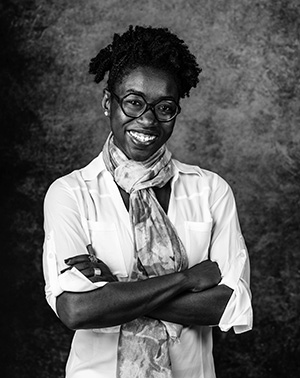
The Researcher ‘Unmasking AI’
With evidence and conviction—two important ingredients to tackling a vast societal issue—Dr. Joy Buolamwini is taking on big tech and the lingering issue of algorithmic bias.
On the September 2020 cover of Fast Company magazine, the glaring brown eyes of Dr. Joy Buolamwini, CS 12, rest beneath oversized white frames. Under the headline “The Most Creative People in Business,” the esteemed business magazine introduces Buolamwini as “The Researcher Who Took on Big Tech—and Won.”
In the digital age, where tech flaunts an outsized impact on society, the thought of battling corporate behemoths like Amazon, Microsoft, and IBM would seem a futile, foolish pursuit.
But Buolamwini, with her eyes pointed ahead, isn’t much for kowtowing to long odds. Her pioneering research on facial recognition and artificial intelligence (AI) biases convinced leading tech companies to slow and re-evaluate their development of such algorithms. Meanwhile, her recent national bestseller, Unmasking AI: My Mission to Protect What Is Human in a World of Machines, urges the larger populace to embrace a deeply critical look at AI’s continued rush into daily life.
“If we’re going to be in a world where AI is so integrated in our life, then how do we make sure this technology is actually moving all of us forward?” Buolamwini asks.
Leading the Charge
The seeds for Buolamwini’s crusade against inadequate AI were planted at Georgia Tech.
As an undergraduate, Buolamwini worked on a project called Peekaboo Simon, which used facial detection to facilitate human-robot interaction. When the technology failed to catch her face, Buolamwini thought it odd. Months later, she encountered a similar experience while attending a student entrepreneurship contest in Hong Kong. The two events spurred questions about the limitations of facial recognition, which Buolamwini initially attributed to issues like lighting or background.
While pursuing graduate work at MIT six years later, Buolamwini again confronted facial detection software struggling to read her face. When she grabbed a white mask, however, the technology responded.
An issue Buolamwini assumed had been addressed lingered, and she questioned if the algorithmic inefficiencies were less about environmental conditions like lighting or background and more about bias. Who holds the power to shape priorities and preferences in technological innovations, she wondered, and how do subjective human choices factor into these emerging technologies?
Quickly, Buolamwini found herself engrossed in research and advocacy, spotlighting an issue with swelling concerns as institutions from law enforcement to healthcare to education pulled AI into their work at an accelerating pace.
Buolamwini tested commercially available AI products and generated powerful empirical evidence of algorithmic bias, efforts enabling her to bat away scrutiny and skepticism.
She published papers capturing the attention of mainstream media and gave a spirited TED Talk—now viewed more than 1.7 million times—introducing the idea of algorithm bias. She launched the Algorithmic Justice League (AJL) and starred in the celebrated documentary Coded Bias. She testified before Congress and spoke at the World Economic Forum.
“This issue needed to be brought to light,” she says.
Driving Awareness
Unmasking AI, which dropped last Halloween, represents Buolamwini’s latest attempt to counter the AI global hype machine and encourage conscientious action from technology leaders and everyday citizens alike. Blending her own personal experiences and diligent research, Buolamwini’s debut work highlights AI’s adverse impact and encourages specific efforts to capture AI’s beneficial promises.
“If people have a face, they have a place in this conversation,” Buolamwini says.
She calls the stakes massive, especially as AI proliferates and governs opportunity, including access to employment, education, and healthcare. If the problem is ignored, she fears progress in areas like women’s rights or accessibility could crumble under the guise of machine neutrality.
“Once we have AI serving as the gatekeepers, it’s imperative we make sure that gatekeeping isn’t narrowing opportunities,” she says.
And slowly, she notes, people are beginning to recognize AI’s limits and issues of algorithmic bias. They’re seeing ubiquitous AI tools misclassifying the iconic faces of people like Oprah Winfrey and Serena Williams. Or they’re reading about people like the eight-months pregnant Porcha Woodruff, who was arrested for carjacking and robbery in Detroit due to a facial recognition mismatch.
“The biggest win will be to change the mindset and perspective of people and organizations,” says Buolamwini, whose work has expanded from biometric rights and into creative rights with generative AI.
An admittedly colossal challenge, but Buolamwini isn’t backing down.
“It’s too important,” she says. “We have to get this right.”
—Daniel P. Smith
A Big Idea Leads to ‘The Greatest Degree Program Ever’
In only 10 years, the Online Master of Science in Computer Science program at Georgia Tech has grown to more than 11,000 alumni.
As a kid growing up in Cuba, Yaima Valdivia had a fascination with science, which extended into computer science, robotics, and AI thanks to a required course in the sixth grade and the novel The Bicentennial Man. After earning her bachelor’s degree, she moved to the United States, where the realities of immigration sidelined her academic aspirations. Valdivia worked as a software engineer for some credit unions in Atlanta and was inspired by Tech’s vibrant community; that exposure grew her admiration for the Institute long before she considered enrolling in any of its programs. When Valdivia was ready to continue her education, the prestige of a Georgia Tech degree, the flexibility of a curriculum that allowed her to continue her career as a senior engineer in Silicon Valley, and the low cost drew her to the Institute’s Online Master of Science in Computer Science (OMSCS).
Since its founding 10 years ago, Georgia Tech’s OMSCS program has helped more than 11,000 students like Valdivia earn an advanced degree from a world-renowned institution for less than $7,000, thanks to the power of technology.
The average cost of a master’s degree in the United States according to the Education Data Initiative is about $66,000. For Zvi Galil, who served as the dean of the College of Computing from 2010 to 2019, that high price tag makes him question the value of higher education. Which is why in 2012, when an education company at the forefront of the creation of massive open online courses (MOOCs) approached him about creating an affordable online program using MOOC technology, Galil jumped at the opportunity.
“I immediately liked the idea because I wanted to improve access to higher education,” Galil says. “There are two parts to this concept of access. One is the tuition, which excludes quite a number of people. The second is the infrastructure and the capacity of the university to support a certain number of students. The solution was to create a high-quality online program that was more affordable than an on-campus program.”
Thanks to a partnership with education company Udacity, a $4 million grant from AT&T, and support from Tech administration and faculty, the Institute’s OMSCS program launched in January 2014 with 380 students. While college enrollment in the United States has dropped 7.4 percent in the last decade, Georgia Tech’s online program is bucking that trend. Today, over 13,300 students from 120 countries are enrolled. In November, a contributor for Forbes.com called OMSCS the greatest degree program ever.
According to David Joyner, CS 08, MS HCI 09, PhD HCC 15, who serves as the executive director of online education and OMSCS, Tech’s program is unique not just because of its affordability.
“Many universities develop online programs that are very distinct from what is offered on campus,” he says. “Ours is the same degree; it’s just off-campus. We started from a foundation of what we were already doing in person and found the minimum number of compromises to go online. That ensures we’re keeping as much of the quality of the in-person program as possible and ensures we’re preserving the rigor and reputation of the degree.”
The online program does differ from its on-campus counterpart on one count: admission requirements. The GRE is not required, and students are accepted tentatively and must earn two As or Bs during their first year to be fully admitted.
“That’s totally opposite from what’s going on in other American universities,” Galil says. “The more students they reject, the prouder they are. In some sense, these universities cannot fulfill their missions. They speak about equity, but they are selective, and they are not accessible. OMSCS came about to help show what’s possible.”
Tech launched two other OMS degrees, one in cyber-security and one in analytics, bringing OMS course options to more than 60. As the online program continues to grow, its leaders have dreams for the future. Galil says he hopes that in his lifetime the online model will extend to undergraduate education as well. Joyner hopes the program will cover more computer science topics in the future and become more interdisciplinary.
“There’s a misconception that if we’re radically increasing the number of Georgia Tech alums out there, it’s diluting what the degree means,” Joyner says. “But it’s not like that. Our OMSCS students come into the program as incredible people, they graduate with a Georgia Tech degree, and they continue to be incredible. We’re able to let people who are phenomenal now also be Georgia Tech people. That’s increasing the reputation of Georgia Tech.” Georgia Tech will be hosting an anniversary reception for the OMSCS program April 29–May 1.
— Kelley Freund
Big Impacts in Tiny Spaces
This is the “Big” issue, but we carved out a tiny section on a few of the outsized ways that Georgia Tech researchers are making big impacts in small, even nano-sized, spaces.
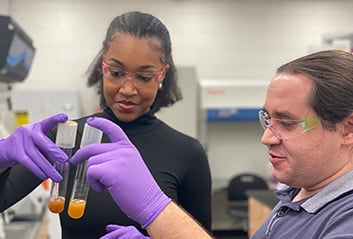
Light-Powered Yeast
Just because something comes in a small package, doesn’t mean it can’t have a big impact. Like rhodopsin, a protein that converts light into energy and is found in a wide range of organisms, from bacteria to humans. As researchers in Associate Professor William Ratcliff’s lab, Anthony Burnetti and Autumn Peterson (pictured above) study major transitions in evolution—the innovations that changed the course of life.
After engineering rhodopsin to the vacuole of single-celled yeast, they found that the yeast, an organism with no evolutionary history of solar-powered growth, divided faster when exposed to light—2 percent faster than they did in the dark. The results can be used to study things like biofuel production and cellular aging, as well as basic evolutionary processes.
“These results can help us understand how a fundamental mode of making a living is acquired by new organisms and put to use,” Ratcliff says. “And we found there was a benefit right away without having evolution to fine-tune it.”
But since the lab’s focus is evolution and multicellular life, the team is taking their results a step further by understanding why the earliest multicellular organisms are photosynthetic.
“The cells in the interior of our multicellular organisms run out of oxygen, and normally this limits their growth. We’re interested in seeing if by engineering the rhodopsins to the vacuole of multicellular yeast, light can compensate for the lack of oxygen,” says Peterson. “Here we’re looking to do an evolution experiment by having them grow for a long period and see if anything changes over time.”
— Kelley Freund
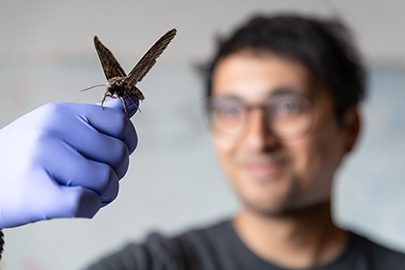
Insects and Robots
Despite having an uncomfortable close encounter with a cicada when he was 6 years old, Associate Professor of Physics and Biological Sciences Simon Sponberg still has respect for insects and their ability to maneuver through almost every environment on the planet.
Many insects use their brain to command their muscles to beat each wing stroke. But smaller insects need more wingbeats per second in order to fly, and at some point their muscles can’t contract and relax fast enough. Instead, the nervous system in insects like bees and mosquitoes sends a pulse to the muscles that causes them to vibrate quickly, before they receive another pulse from the brain. This asynchronous flight allows them to flap their wings at high rates. At least four different, large groups of insects are capable of asynchronous flight, and while it was previously thought that each group evolved the trait separately, research from Tech and the University of California San Diego show that they most likely evolved from a common ancestor, that evolution has turned on and off this mode of flight over time, and that some insects, like moths and butterflies, have the capacity for both regular and asynchronous flight. The discovery prompted the research team to then build a robot capable of switching between the two modes. Studying the flight patterns of insects informs us not just about evolution, but about engineering small flapping systems.
“One of the big frontiers we see in robotics is the design of autonomy in small packages,” Sponberg says. “Centimeter scale is hard to design. We do really well with tiny micro robots and big robots, and we have good sensors, processors, and motors that are a centimeter long. But putting them all together in a small package in a way that it can still fly is really challenging.”
— Kelley Freund
